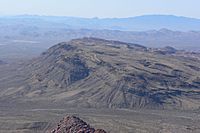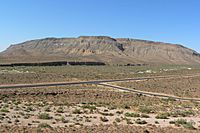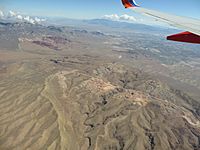Blue Diamond Hill facts for kids
Blue Diamond Hill is a mountain peak that stands about 4,931 feet (1,503 meters) tall. It is located near Las Vegas in Nevada, right next to the beautiful Red Rock Canyon. A mine called the Blue Diamond Mine is on the hill, and a small town named Blue Diamond, Nevada is also nearby. For many years, there have been ideas to build new homes on Blue Diamond Hill.
What is Blue Diamond Hill?
Blue Diamond Hill is a large rock formation that was pushed up from the ground. It is made of old rocks from the Permian and Triassic periods. Nevada has many types of cactus, and 25 of them can be found on Blue Diamond Hill! One special cactus is the Blue Diamond cholla. You can also see Joshua trees and other desert plants like yucca and globe mallows here.
People started mining for gypsum on the hill in 1925. Gypsum is a mineral used to make things like drywall. In the 1990s, workers carefully moved about 17,000 plants from the mining areas. They were replanted in a desert park in Logandale, Nevada. The Blue Diamond cholla cactus is an endangered plant. It was protected thanks to an agreement between the mining company, the Bureau of Land Management (BLM), and a group called The Nature Conservancy.
Around the year 2000, there were about 6,000 Blue Diamond cholla plants on the mountain. Later, people found out that this cactus also grows in other places in Clark County, Nevada and Arizona. In 2005, a count found 56,000 Blue Diamond chollas in these areas. The ones on Blue Diamond Hill are the easiest to reach. Even with more found, the state still listed the Blue Diamond cholla as critically endangered in 2010.
Plans for the Hill
Over the years, there have been different ideas for building on Blue Diamond Hill.
Power Plant Idea
In the late 1980s, there was a plan to build a large power plant on Blue Diamond Hill. This plant would have used water to make electricity, which is called hydroelectric power. At first, people living nearby were worried about the project. To help with these worries, the proposed spot for the plant was moved further away from Red Rock Canyon.
However, local planners were still concerned about how the plant would look. They also worried about dust during construction and how it might affect the environment. Environmental groups were especially concerned about the endangered Blue Diamond cholla cactus. The power plant would have taken up about 104 acres of land. But it was also expected to bring in a lot of money for the state and local taxes.
In 1996, an environmental study for the project was approved. The project was also approved by a federal energy group a year later. By 2001, the project was almost ready to start building. However, some local leaders were unsure about approving it. Many residents were worried about the plant changing the beautiful scenery. Environmentalists felt the plant was not needed. A group called The Sierra Club even said the plant would be inside Red Rock Canyon. The BLM, which manages the land, said this was not true.
In 2001, the company planning the power plant decided to ask for a federal permit instead of a local one. A U.S. senator named Harry Reid tried to help the project move forward. But he put the plan on hold until environmental concerns could be solved. The project also needed local approval and permission from the water district. As of 2003, the power plant had not been built, and it remains unbuilt today.
Housing Projects
In 2002, a company wanted to build a huge neighborhood on Blue Diamond Hill. This plan would have brought about 21,000 new people to the area. But many people were against it, so the plan was stopped later that year.
In 2003, a developer named Jim Rhodes bought land on Blue Diamond Hill. Since then, he has also suggested building many homes there. However, these housing plans have also faced a lot of opposition from the community.




